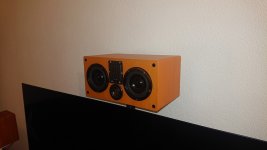I use the program XDir to calculate lobing at crossover frequencies.
You can get it at Tolvan Data
I've used it to calculate the lobing of my 3-way center speaker, between the planar mid and AMT tweeter. The crossover is active 4th order at 8 kHz.
The lobing pattern is not ideal, I had to reverse the polarity of the tweeter because my ears were in a null at the listening position.
When the lobing pattern is bad, I can recommend a 4th order crossover, it does not decrease lobing, but it reduces the frequency band in which it occurs.
You can get it at Tolvan Data
I've used it to calculate the lobing of my 3-way center speaker, between the planar mid and AMT tweeter. The crossover is active 4th order at 8 kHz.
The lobing pattern is not ideal, I had to reverse the polarity of the tweeter because my ears were in a null at the listening position.
When the lobing pattern is bad, I can recommend a 4th order crossover, it does not decrease lobing, but it reduces the frequency band in which it occurs.
Attachments
Many thanks,
my everyday loudspeaker has a 4th order tweeter on a second order mid... and I like it very much (tweeter with reversed polarity)
But on that casual design which is a also a first for me, I don't want to spend too much money... find it already expensive and much more than a good second hand, although I am making it for fun and to learn from also a listening try & error perspective.🙄 4th order is expensive on parts with passive filters. I hesitated with the super tweeter cut-off very high, leting the 10F full range in the highs without low pass with a super tweeter. Seems it's a bad idea !
I try to stay with not very much expensive parts - I already had the SS 10F- and cabinetry -I chose already veneered ply for instance that you can see in the picture-
Yes I like Tolvan tools. Do you know please, if in the Edge when you enter the diameter of the driver if it is the full diameter size with the metal frame or the diameter of the cone with half of the surrounds, i.e. the radiating area ?
my everyday loudspeaker has a 4th order tweeter on a second order mid... and I like it very much (tweeter with reversed polarity)
But on that casual design which is a also a first for me, I don't want to spend too much money... find it already expensive and much more than a good second hand, although I am making it for fun and to learn from also a listening try & error perspective.🙄 4th order is expensive on parts with passive filters. I hesitated with the super tweeter cut-off very high, leting the 10F full range in the highs without low pass with a super tweeter. Seems it's a bad idea !
I try to stay with not very much expensive parts - I already had the SS 10F- and cabinetry -I chose already veneered ply for instance that you can see in the picture-
Yes I like Tolvan tools. Do you know please, if in the Edge when you enter the diameter of the driver if it is the full diameter size with the metal frame or the diameter of the cone with half of the surrounds, i.e. the radiating area ?
Last edited:
cool, that's what I enter in the Edge🙂 .... the bafle is 28 cm width and the mid is around 11 cm from the first horizontal edge...
I use the program XDir to calculate lobing at crossover frequencies.
That program is absolutely worthless because it does not provide information what kind of lobing is really bad and what is almost harmless for sound balance.
the Edge
...and the Edge cannot calculate high off-axis angles due to diffraction model so it's wothtless for creating simulated directivity for quasi full space simulation at LF. In addition it does not include any smoothing with rounded edges.
Just forget all Tolvan.
To be fair, this is a useful way to see data when prototyping a concept. The fact that it is a simple model makes sure the concept is clear for the designer to see.That program is absolutely worthless
Also, programs that estimate the results can give a false sense of confidence in the data.
^Bollocks. Tool capable to calculate directivity benchmarks such as power response and early reflections RMS is able to show also polar chart in vertical plane at selected frequency. XDir is just limited crap and that's it.
The best use of any software is when the user can see the boundary between its best information and its limits. Its signal to noise.
All software has limitations, but you will get credible data if you know what the limits are. An experienced designer would never blindly trust software unless they can clearly see where those limits are.
All software has limitations, but you will get credible data if you know what the limits are. An experienced designer would never blindly trust software unless they can clearly see where those limits are.
- Home
- Loudspeakers
- Multi-Way
- Let's talk about XO above 10K hz & 1/4 WL law

